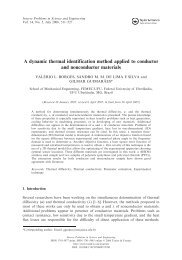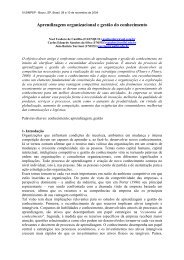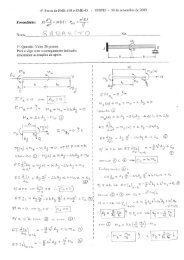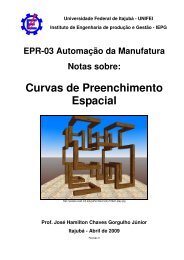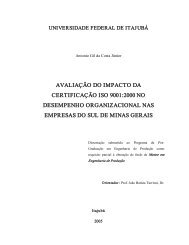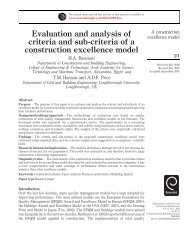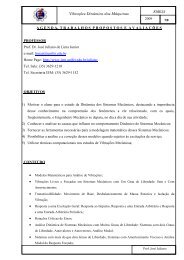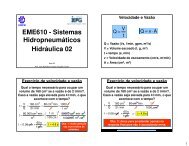Numerical simulation of two-dimensional flows over a circular ...
Numerical simulation of two-dimensional flows over a circular ...
Numerical simulation of two-dimensional flows over a circular ...
Create successful ePaper yourself
Turn your PDF publications into a flip-book with our unique Google optimized e-Paper software.
A.L.F. Lima E Silva et al. / Journal <strong>of</strong> Computational Physics 189 (2003) 351–370 355Fig. 2. Scheme for the pressure and velocity interpolation.The different terms described by Eqs. (9)–(12) must be evaluated <strong>over</strong> the interface using the velocity field~V ð~xÞ and pressure field Pð~xÞ. These calculations must also take into account that, at the interface, the fluidvelocity must be equal to the interface velocity, which guarantees the no-slip condition. The velocity andpressure spatial derivatives are calculated using the fluid velocity and pressure obtained by Eqs. (2) and (3).One <strong>of</strong> the possible ways to do this is to interpolate ~V ð~xÞ and Pð~xÞ <strong>over</strong> appropriate points near the interface,as illustrated by Fig. 2. This interpolation method is described in the following section.2.3. Interpolation and derivatives calculation procedureThe interpolation scheme for the horizontal velocity, <strong>over</strong> point number 3, for example, is shown inFig. 3. A square dotted domain is defined as being the region where the variables will be analyzed. In theFig. 3. Interpolation scheme for the horizontal velocity at point 3.
In Fig. 4, the vertical velocity components are shown for the interpolation scheme <strong>over</strong> point 3. Thesame procedure is used to obtain the interpolated pressure value. The interpolations <strong>over</strong> the other points(1, 2 and 4), are also done the same way. For the points <strong>over</strong> the interface (k points), the procedure isdifferent. The velocity components are interpolated using the internal and external grids (Fig. 5(a)). Thepressure is taken as the value at a Dx distance from point k, in the normal direction, as shown in Fig. 5(b).Point p belongs to the nearest external Eulerian cell from point k.The pressure and velocity derivatives, that appear in Eqs. (9)–(12), are calculated using a secondorderLagrange polynomial approximation. Generalizing the vertical and horizontal velocity componentsand the pressure by /, the first and second derivatives in the x direction are approximatedby:o/ox ðx k; y k Þ¼ðx k x 2 Þðx 1 x 2 Þðx 1 x k Þ / ðx k x 1 Þ1 þðx 2 x 1 Þðx 2 x k Þ / 2 þ ðx k x 1 Þþðx k x 2 Þ/ðx k x 1 Þðx k x 2 Þ k ; ð13Þo 2 /ox ðx 2/k; y 2 k Þ¼1ðx 1 x 2 Þðx 1 x k Þ þ 2/ 2ðx 2 x 1 Þðx 2 x k Þ þ 2/ kðx k x 1 Þðx k x 2 Þ : ð14ÞThe derivatives in the y direction are given by:o/oy ðx k; y k Þ¼A.L.F. Lima E Silva et al. / Journal <strong>of</strong> Computational Physics 189 (2003) 351–370 357ðy k y 4 Þðy 3 y 4 Þðy 3 y k Þ / ðy k y 3 Þ3 þðy 4 y 3 Þðy 4 y k Þ / 4 þ ðy k y 3 Þþðy k y 4 Þ/ðy k y 3 Þðy k y 4 Þ k ; ð15Þo 2 /oy ðx 2/k; y 2 k Þ¼3ðy 3 y 4 Þðy 3 y k Þ þ 2/ 4ðy 4 y 3 Þðy 4 y k Þ þ 2/ kðy k y 3 Þðy k y 4 Þ ; ð16Þwhere / 1 , / 2 , / 3 and / 4 are obtained by the interpolation described in Figs. 3–5. The interface velocitycomponents ðu k ; v k Þ, are also used for the derivative calculation. These velocity components are equal tozero for the purposes <strong>of</strong> the present work, for which the interface is stationary. The pairs ðx k ; y k Þ,ðx 1 ; y 1 Þ, ðx 2 ; y 2 Þ, ðx 3 ; y 3 Þ and ðx 4 ; y 4 Þ are the coordinates <strong>of</strong> the points k, 1, 2, 3 and 4, respectively, asshown in Fig. 2. We emphasize that the derivatives expressed by Eqs. (13)–(16) are calculated <strong>over</strong> theinterface at points ðx k ; y k Þ. The distances between the points k and 1, k and 3, 1 and 2, and 3 and 4 areDx (the mesh size). Their distribution is always at the outside part <strong>of</strong> the immersed boundary. Using thesignal <strong>of</strong> the normal vector components, it is possible to conveniently locate these points, outside theinterface. Therefore, the calculation <strong>of</strong> the force terms, Eqs. (10)–(12), is independent <strong>of</strong> the internalflow properties.The acceleration force qðo~V =otÞ, Eq. (9), is calculated taking into account that the fluid velocity <strong>over</strong> theinterface must have the same value as the interface velocity. Therefore, this acceleration term is approximatedby ðqð~V k~V fk ÞÞ=Dt, where ~V k ¼ðu k ; v k Þ is the interface velocity and ~V fk ¼ðu fk ; v fk Þ is the fluid velocityat the same position on the interface.Once calculated, the Lagrangian force, given by Eq. (8), is distributed <strong>over</strong> the neighboring Euleriangrid, as illustrated in Fig. 6.The Dirac delta function, that appears in Eq. (4), is replaced by the distribution function, in order tocalculate the Eulerian force, in a discrete form. Therefore Eq. (4) is replaced by~F ij ¼ X D ij~ fk Ds 2 ; ð17Þwhere D ij is given by Eqs. (5)–(7) and Ds is the distance between <strong>two</strong> Lagrangian points. The presentedmathematical model is solved using the numerical method described in the following section.
358 A.L.F. Lima E Silva et al. / Journal <strong>of</strong> Computational Physics 189 (2003) 351–370Fig. 6. Illustration <strong>of</strong> the force distribution process.3. <strong>Numerical</strong> methodEqs. (2) and (3) were discretized using the second-order finite central difference method in space and aEuler first order in time. The velocity and pressure coupling was solved using a second-order pressurecorrection method, as presented by Armfied and Street [1]. This method is described as follows:u nþ1iDtu n i¼1 qop nox iNðu n i ÞþLðun i ÞþF ni ;ð18Þo 2 u nþ1ox i ox i¼ q Dtou nþ1iox i; ð19Þu nþ1i¼ u nþ1iDtqou nþ1ox i; ð20Þp nþ1 ¼ p n þ u nþ1 ;ð21ÞwhereLðu i Þ¼ l qo 2 u iox j ox j;ð22ÞNðu i Þ¼ oðu iu j Þox j; ð23Þwhere u i is the estimated velocity component, u is the pressure correction and Dt and n are the computationaltime step and the sub-step indices, respectively. The numerical solution <strong>of</strong> these equations is derivedas follows:1. Calculate the force field ~ f ð~x k Þ, <strong>over</strong> the Lagrangian points ðx k ; y k Þ, using Eqs. (8)–(12) and the initialconditions.2. Distribute the force ~ f ð~x k Þ to the Eulerian grid using Eq. (17).3. Estimate the fluid velocity field under the influence <strong>of</strong> the force field ~F using Eq. (18).
A.L.F. Lima E Silva et al. / Journal <strong>of</strong> Computational Physics 189 (2003) 351–370 3594. Solve the linear system for the pressure correction given by Eq. (19).5. Compute the actual pressure field using Eq. (21).6. Update the fluid velocity using Eq. (20).7. Verify the divergence using Eq. (3).This procedure completes the time step loop. Normally, one loop is sufficient to obtain the mass conservation,verified in step (7). The convergence criterion used for all the <strong>simulation</strong>s was thatmaxf ~r~V g 6 10 8 , where the max value is calculated <strong>over</strong> the entire domain.The resulting linear system for the pressure correction u is solved using the interactive solver MSI(Modified Strongly Implicit Procedure) <strong>of</strong> Schneider and Zedan [19]. Note that the interface force fieldcalculation and the momentum equation solution are performed in an explicit way.4. ResultsThe immersed boundary method, using the Physical Virtual Model, has been applied to simulate aninternal channel flow and the flow around a <strong>circular</strong> cylinder in order to validate the methodology and thenumerical procedure. For the <strong>two</strong>-<strong>dimensional</strong> Poiseuille flow <strong>simulation</strong>, the channel walls where modeledusing the PVM model. Simulations <strong>of</strong> the flow past a <strong>circular</strong> cylinder were done for different low Reynoldsnumbers and consequently, the drag and lift coefficients, the length <strong>of</strong> the recirculation bubble and thepressure coefficient on the cylinder surface were obtained. These results were compared with results presentby other authors.4.1. Poiseuille flowFig. 7 shows the steady state <strong>of</strong> a vertical velocity pr<strong>of</strong>ile in a vertical channel <strong>of</strong> width h and length L.This <strong>simulation</strong> was performed using a 100 200 grid in the x and y directions, respectively. A constantpressure gradient was imposed on the channel and the force field was calculated at the channel walls. ThisFig. 7. (a) Force field at the channels walls. (b) Detail <strong>of</strong> the force at the wall. (c) Vertical velocity pr<strong>of</strong>ile at y ¼ 2. The continuous linerepresents the analytical result and the crosses the numerical result.
360 A.L.F. Lima E Silva et al. / Journal <strong>of</strong> Computational Physics 189 (2003) 351–370result was compared with the result obtained by the analytical solution. We would like to stress thatboundary conditions <strong>over</strong> the walls were modeled using the immersed boundary method, instead <strong>of</strong> theclassic no-slip velocity condition.The maximum velocity error obtained comparing the present result with analytical solution, was 1.0%.4.2. Flow <strong>over</strong> a <strong>circular</strong> cylinderA rectangular domain was used to simulate the flow <strong>over</strong> a stationary cylinder. The boundary conditionswere imposed in such a way that the flow was from the bottom up toward the top <strong>of</strong> the domain. A <strong>circular</strong>cylinder was placed inside the domain so that its center had coordinates x ¼ 7:5d and y ¼ 16:5d. Thedomain had a length <strong>of</strong> 30d and a width <strong>of</strong> 15d. These dimensions were chosen in order to minimize theboundary effects on the flow development. A Newman boundary condition was used on the lateralboundaries. A constant velocity pr<strong>of</strong>ile U 1 was specified at the domain entrance.A grid refinement study was done to verify the result independence and the accuracy <strong>of</strong> the method. Theresults are shown in Table 1 for five grid sizes. They became grid independent for a grid <strong>of</strong> 150 300 pointsand all results presented in this paper were obtained for a grid <strong>of</strong> 250 500 points.Fig. 8 shows the 250 500 uniform mesh used in the <strong>simulation</strong>s <strong>of</strong> flow past a stationary <strong>circular</strong>cylinder <strong>of</strong> diameter d ¼ 0:1. Simulations were performed at Re ¼ 10, 20, 40, 50, 60, 80, 100, 150, and 300.Table 1A grid refinement studyRe ¼ 80Dx ¼ Dy Grid points C D0.0150 100 200 1.3600.0120 125 250 1.4090.0100 150 300 1.3940.0075 200 400 1.3980.0060 250 500 1.396Fig. 8. (a) Complete view <strong>of</strong> the domain with the <strong>circular</strong> cylinder placed inside a vertical channel and (b) zoom view <strong>of</strong> the Cartesianand Lagrangian grids.
A.L.F. Lima E Silva et al. / Journal <strong>of</strong> Computational Physics 189 (2003) 351–370 361The velocity was imposed in such a way that the desired Reynolds number was obtained. The fluidproperties q and l were considered constants and were the same for all <strong>simulation</strong>s.The criterion for the determination <strong>of</strong> the number <strong>of</strong> Lagrangian points was such as Ds=Dx 6 0:9. Thisimplies that, in the present method, we can use a reduced number <strong>of</strong> Lagrangian points, as compared withSaiki and Biringen [18], who used a refined Lagrangian mesh in their <strong>simulation</strong>s.The Reynolds number in this flow was defined asRe ¼ qU 1d; ð24Þlwhere d is the cylinder diameter. Finally, the dimensionless time was defined asT ¼ U 1td : ð25ÞOnce the velocity and pressure fields are calculated, the drag and lift coefficients and the Strouhalnumber can also be calculated, using the force field directly.Drag coefficient. As demonstrated by Lai and Peskin [10], the drag force on an immersed body in astream, arises from <strong>two</strong> sources: the shear stress and the pressure distribution along the body. The dragcoefficient can be defined asC D ¼F Dð1=2ÞqU 2 1 d ;ð26Þwhere F D is the drag force. Here, it can be calculated using the Eulerian force or the Lagrangian force as:Z Z LF D ¼ F x dx ¼ f x ds;ð27ÞX0where F x and f x are the x components <strong>of</strong> the Eulerian and Lagrangian force, respectively, L is the length <strong>of</strong>the interface and X is a domain which contains the interface.Lift coefficient. Similar to the drag coefficient, the lift coefficient can be defined asC L ¼F Lð1=2ÞqU 2 1 d ;ð28Þwhere F L is the lift force, which can be calculated using the y component <strong>of</strong> the Eulerian force or theLagrangian force asZ Z LF L ¼ F y dy ¼ f y ds;ð29ÞX0where F y and f y are the y components <strong>of</strong> the Eulerian and Lagrangian forces, respectively.Strouhal number. The Strouhal number is defined as the dimensionless frequency with which the vorticesare shed behind the bodySt ¼ fd ;ð30ÞU 1where f is the vortex shedding frequency. This frequency can be obtained using the Fast Fourier Transform<strong>of</strong> the lift coefficient time distribution.A small time step ðDt ¼ 1 10 6 Þ was used at the first loop, in order to guarantee the code stability. It isincreased as the flow develops. When the force field is enough to satisfy the no-slip condition on the cylinder
362 A.L.F. Lima E Silva et al. / Journal <strong>of</strong> Computational Physics 189 (2003) 351–370surface, the time step is <strong>of</strong> 1 10 3 . This time step is <strong>of</strong> the order <strong>of</strong> that used by others authors (i.e., Laiand Peskin [10]). The results obtained with this time step, for Re ¼ 80, compare very well with othersauthors results. Although, by security measure the authors have used a time step <strong>of</strong> Dt ¼ 1:10 4 for allcalculation presented in the present paper.For Reynolds number equal to 10, 20 and 40 the wake formed behind the cylinder attains a steadysymmetric state, which is in agreement with the well-established result, by the linear stability theory. Thecylinder wake instabilities rises for Re P 47.Fig. 9 shows the recirculation bubble behind the cylinder at Re ¼ 10, 20 and 40, respectively, in thesteady flow regime. The bubble increases with the Reynolds number.The force components ðF x ; F y Þ distributed near the solid interface are shown in Fig. 10. We observe that itis different from zero also inside the interface. In fact, we have a velocity field inside this interface but it doesFig. 9. Flow past a <strong>circular</strong> cylinder. Streamline visualization: (a) Re ¼ 10, (b) Re ¼ 20 and (c) Re ¼ 40.Fig. 10. Force field illustration for Re ¼ 40: (a) F x , (b) F y .
A.L.F. Lima E Silva et al. / Journal <strong>of</strong> Computational Physics 189 (2003) 351–370 363not affect the Lagrangian force calculation because only the external fields are used during the interpolationprocess.The Lagrangian force terms, i.e., ~ f a (the acceleration force), ~ f i (the inertial force), ~ f v (the viscous force)and ~ f p (the pressure force) are given by Eqs. (9)–(12). Their temporal evolution is shown in Figs. 11–13. InFig. 11(a) the points A and B represent the positions where this terms are analyzed.Fig. 11. Specific points used to analyze the Lagrangian force components (a); temporal variation <strong>of</strong> the vertical acceleration force atpoint B and vertical component <strong>of</strong> the velocity, inside the bubble recirculation, at point C (b).Fig. 12. Temporal variation <strong>of</strong> the Lagrangian force components at Point A: horizontal component and vertical component (b).Fig. 13. Temporal variation <strong>of</strong> the Lagrangian force components at Point B: horizontal component and vertical component (b).
364 A.L.F. Lima E Silva et al. / Journal <strong>of</strong> Computational Physics 189 (2003) 351–370Fig. 11(b) shows the variation <strong>of</strong> the vertical component <strong>of</strong> the acceleration force ðf ay Þ, at point B, andthe temporal variation <strong>of</strong> the vertical component <strong>of</strong> the fluid velocity ðvÞ, at point C. The components (xand y) <strong>of</strong> all force terms extracted at the point A, on the left side <strong>of</strong> the cylinder, can be visualized in Fig. 12.The horizontal and the vertical force components are shown in Figs. 12(a) and (b), respectively, as afunction <strong>of</strong> the non-<strong>dimensional</strong> time. Fig. 13 shows the same force components at point B.We see that the vertical velocity component (Fig. 11(b)) presents an oscillating behavior, correspondingto the vortices shedding process behind the cylinder. All force components (Figs. 11–13) presents the samebehavior as the vertical velocity component, showing that the force calculation takes into account theneighboring flow dynamic. The vortices shedding process determines the frequencies and the amplitude <strong>of</strong>the force oscillations.The acceleration force ~ f a ¼ðf ax ; f ay Þ might tend to zero if the Lagrangian force had been calculatedimplicitly in such a way that at each time the iterative process could bring this term ð ~ f a Þ to zero, before toadvance to the next time. As the calculation were performed in a explicit way, it cannot be zero because theforce used at time t þ Dt is calculated at the time t. It is very important to stress that at each time theacceleration force assumes a value different from zero due to the fact that the fluid velocity at the interface isrecalculated at each time and, consequently, it assume a value different from zero.All force components present the same oscillating behavior, with the same frequency, but with differentamplitude levels. The acceleration force assumes a very important role to compose the total force. Thepressure force is the second more important, the viscous force is third more import and the inertial force isnegligible as compared with the others terms.The no-slipping boundary condition must be guaranteed by this force field. The fluid velocity at theLagrangian point q<strong>over</strong> ffiffiffiffiffiffiffiffiffiffiffiffiffiffiffiffiffiffiffiffiffiffiffiffiffiffiffiffiffiffiffiffiffiffiffithe solid/fluid interface is obtained by interpolating the nearest velocity field. WePdefine here l 2 ¼ Nk¼1 ðu2 k þ v2 k Þ=N as a parameter that shows how good is the model in the sense that noslipping boundary condition must be assured. Fig. 14 shows the time evolution for the parameter l 2 , whichtends to zero as time pass. For this <strong>simulation</strong> l 2 is <strong>of</strong> the order 10 4 . Fig. 15 shows the pressure field for sixReynolds numbers and Fig. 16 shows the corresponding vorticity field. It can be visualized in both figuresthat for Reynolds 20 and 40 the flow is symmetric. For Reynolds 80 the instabilities take place and the flowis completely asymmetric.The length <strong>of</strong> the bubble recirculation ðL w Þ is here defined as the distance between <strong>two</strong> stagnationpoints downstream <strong>of</strong> the cylinder, as illustrated by Fig. 17. It was determined using the vertical velocityFig. 14. Time evolution <strong>of</strong> the parameter l 2 , for Re ¼ 10.
A.L.F. Lima E Silva et al. / Journal <strong>of</strong> Computational Physics 189 (2003) 351–370 365Fig. 15. Pressure field. (a) Re ¼ 20, (b) Re ¼ 40, (c) Re ¼ 80, (d) Re ¼ 100, (e) Re ¼ 150 and (f) Re ¼ 300.Fig. 16. Vorticity field. (a) Re ¼ 20, (b) Re ¼ 40, (c) Re ¼ 80, (d) Re ¼ 100, (e) Re ¼ 150 and (f) Re ¼ 300.
366 A.L.F. Lima E Silva et al. / Journal <strong>of</strong> Computational Physics 189 (2003) 351–370distribution, plotted <strong>over</strong> the central streamline downstream <strong>of</strong> the cylinder. Fig. 18 shows these distributionsas a function <strong>of</strong> y, for different values <strong>of</strong> Reynolds number. The second point, <strong>over</strong> this streamline,where the velocity is zero gives the L w measure. Fig. 19 shows the L w distribution as a function <strong>of</strong> theReynolds number. Comparisons <strong>of</strong> the present results with those <strong>of</strong> other authors [13,14] demonstrate goodagreement.The drag coefficient as a function <strong>of</strong> the dimensionless time for different values <strong>of</strong> the Reynolds numberis shown in Fig. 20. These results were obtained using Eq. (24).Fig. 21 shows the lift coefficient as a function <strong>of</strong> time for different Reynolds numbers. These results wereobtained using Eq. (28). It should be noted that for Re ¼ 45 the flow is still stable. As the Reynolds numberincreases the flow becomes unstable. The critical Reynolds number is approximately Re ¼ 47, as predictedby the linear theory <strong>of</strong> stability.The h orientation angle, illustrated by Fig. 22, varies from 0 to 180°, between the <strong>two</strong> stagnation points.Fig. 23 shows the pressure coefficient on the cylinder surface, defined as C p ¼ p k =0:5qU1 2 [22], as a function<strong>of</strong> the angle h, as illustrated by Fig. 22. The pressure is taken on the Lagrangian points ~x k . U 1 is the freestream velocity.The comparison <strong>of</strong> the drag coefficient, obtained in the present work, with other numerical and experimentalresults, is presented in Table 2. Very good agreement has been obtained [5,11,23,26].Fig. 17. Length <strong>of</strong> the bubble recirculation.Fig. 18. Vertical velocity component ðvÞ as a function <strong>of</strong> y. L w determination.
A.L.F. Lima E Silva et al. / Journal <strong>of</strong> Computational Physics 189 (2003) 351–370 367Fig. 19. Bubble recirculation length ðL w =dÞ as a function <strong>of</strong> the Reynolds number.Fig. 20. Drag coefficients as a function <strong>of</strong> the dimensionless time: (a) Re ¼ 10, 20, 40 and 50; (b) Re ¼ 80, 100, 150 and 300.Fig. 21. Variation <strong>of</strong> lift coefficients with time: (a) Re ¼ 45 and 47; (b) Re ¼ 50 and 80.
368 A.L.F. Lima E Silva et al. / Journal <strong>of</strong> Computational Physics 189 (2003) 351–370Fig. 22. Schematic illustration <strong>of</strong> the angle h.Fig. 23. Pressure coefficient distribution, between the stagnation points ðh ¼ 0Þ and ðh ¼ 180Þ: (a) Re ¼ 10, 20, 40 (present study);.: Re ¼ 10, 20, 40 [14]; (b) Re ¼ 50, 80, 100, 150 (present study);O: Re ¼ 80, 100 [14].Table 2Comparison <strong>of</strong> mean drag coefficient (C D ) with those <strong>of</strong> other authorsRe Present work Park et al.[14]Sucker and Brauer[17]Dennis and Chang[2]Ye et al.[26]10 2.81 2.78 2.6720 2.04 2.01 2.08 2.05 2.03 2.2240 1.54 1.51 1.73 1.52 1.52 1.4847 1.46 – – – – –50 1.46 – 1.65 – – –80 1.40 1.35 1.51 – 1.37 1.29100 1.39 1.33 1.45 – – –150 1.37 – 1.36 – – –300 1.27 1.37 1.22 – 1.38 –Tritton[20]
A.L.F. Lima E Silva et al. / Journal <strong>of</strong> Computational Physics 189 (2003) 351–370 369Fig. 24. Strouhal number vs. Reynolds number.Fig. 24 shows the Strouhal number, defined by Eq. (30), as compared with the Strouhal number obtainedby other authors [16,25,26]. It should be noted that for low Reynolds numbers the results are in goodagreement [9,14,24]. As the Reynolds number increases the error factor <strong>of</strong> the numerical <strong>simulation</strong> increases.The present work presents consistent results even for Re ¼ 300.5. ConclusionsThe Physical Virtual Model (PVM), proposed in the present work, permits the <strong>simulation</strong> <strong>of</strong> unsteady,viscous incompressible <strong>flows</strong> <strong>over</strong> an immersed <strong>circular</strong> cylinder using a Cartesian grid. Statistical parameters,including drag and lift coefficients, the Strouhal number, wall pressure and the length <strong>of</strong> thebubble recirculation, were reported for several values <strong>of</strong> the Reynolds number. The results show consistencyagreement with previous numerical and experimental results. The proposed model seems to be apromising tool and can be also applied to other geometries, to mobile geometries and to higher Reynoldsnumbers. The CPU time used to compute 10 s <strong>of</strong> <strong>simulation</strong>, for Re ¼ 80, was approximately 36 h in aPentium IV, 2 GHz. This time was sufficient to obtain the statistic parameters and it is compatible withother methods such as Finite-Volume and the Lattice–Boltzman Methods.AcknowledgementsThe authors acknowledge Fundacß~ao CAPES for the financial support. The computations were performedon a Pentium IV 2.0 GHz, at the Mechanical Engineering College <strong>of</strong> the Federal University <strong>of</strong>Uberl^andia.References[1] S. Armfield, R. Street, The fractional-step method for the Navier–Stokes equations on staggered grids: the accuracy <strong>of</strong> threevariations, J. Comp. Phys. 153 (1999) 660.[2] S.C.R. Dennis, G. Chang, <strong>Numerical</strong> solutions for steady flow past a <strong>circular</strong> cylinder at Reynolds numbers up to 100, J. FluidMech. 42 (1970) 471.[3] E.A. Fadlun, R. Verzicco, P. Orlandi, J. Mohd-Yous<strong>of</strong>, Combined immersed-boundary finite-difference methods for three<strong>dimensional</strong>complex <strong>flows</strong> <strong>simulation</strong>s, J. Comp. Phys. 161 (2000) 35.
370 A.L.F. Lima E Silva et al. / Journal <strong>of</strong> Computational Physics 189 (2003) 351–370[4] A.L. Fogelson, C.S. Peskin, A fast numerical method for solving three-<strong>dimensional</strong> Stokes equation in the presence <strong>of</strong> suspendedparticles, J. Comp. Phys. 79 (1988) 50.[5] B. Fornberg, A numerical study <strong>of</strong> steady viscous flow past a <strong>circular</strong> cylinder, J. Fluid Mech. 98 (1980) 819.[6] D. Goldstein, R. Hadler, L. Sirovich, Modeling a no-slip flow boundary with an external force field, J. Comp. Phys. 105 (1993)354.[7] D. Goldstein, R. Hadler, L. Sirovich, Direct numerical <strong>simulation</strong> <strong>of</strong> turbulent flow <strong>over</strong> a modelled riblet c<strong>over</strong>ed surface,J. Comp. Phys. 302 (1995) 333.[8] D. Juric, Computation <strong>of</strong> phase change, Ph.D. Thesis, Mechanical Engineering, University <strong>of</strong> Michigan, USA, 1996.[9] J. Kim, D. Kim, H. Choi, An immersed-boundary finite-volume method for <strong>simulation</strong>s <strong>of</strong> flow in complex geometries, J. Comp.Phys. 171 (2001) 132.[10] M.C. Lai, C.S. Peskin, An immersed boundary method with formal second-order accuracy and reduced numerical viscosity,J. Comp. Phys. 160 (2000) 705.[11] R. Mittal, S. Balachandar, Inclusion <strong>of</strong> three-<strong>dimensional</strong> effects in <strong>simulation</strong>s <strong>of</strong> <strong>two</strong>-<strong>dimensional</strong> bluff-body wake <strong>flows</strong>, ASMEFluids Engineering Division Summer Meeting, 1997.[12] J. Mohd-Yus<strong>of</strong>, Combined immersed boundaries/B-splines methods for <strong>simulation</strong>s <strong>of</strong> <strong>flows</strong> in complex geometries, CTR AnnualReserch Briefs, NASA Ames/Stanford University, 1997.[13] M. Nishioka, H. Sato, Mechanism <strong>of</strong> determination <strong>of</strong> the shedding frequency <strong>of</strong> vortices behind a cylinder at low Reynoldsnumbers, J. Fluid Mech. 89 (1978) 49.[14] J. Park, K. Kwon, H. Choi, <strong>Numerical</strong> solutions <strong>of</strong> flow past a <strong>circular</strong> cylinder at Reynolds number up to 160, KSME Int. J. 12(1998) 1200.[15] C.S. Peskin, <strong>Numerical</strong> analysis <strong>of</strong> blood flow in the heart, J. Comp. Phys. 25 (1977) 220.[16] A. Roshko, On the wake and drag <strong>of</strong> bluff bodies, J. Aeronaut. Sci. 22 (1955) 124.[17] D. Sucker, H. Brauer, Fluiddynamik bei der angestromten Zilindern, W€arme St<strong>of</strong>fubertragung 8 (1975) 149.[18] E.M. Saiki, S. Biringen, <strong>Numerical</strong> <strong>simulation</strong> <strong>of</strong> a cylinder in uniform flow: application <strong>of</strong> a virtual boundary method, J. Comp.Phys. 123 (1996) 450.[19] G.E. Schneider, M. Zedan, A modified strongly implicit procedure for the numerical solution <strong>of</strong> field problems, Numer. HeatTransfer 4 (1981) 1.[20] D.J. Triton, Experiments on the flow past a <strong>circular</strong> cylinder at low Reynolds number, J. Fluid Mech. 6 (1959) 547.[21] Q. Wang, K.D. Squires, Int. J. Multiphase Flow 22 (1996).[22] F.M. White, Viscous Fluid Flow, second ed., McGraw-Hill, New York, 1991.[23] C. Wieselsberger, New data on the laws <strong>of</strong> fluid resistance, NACA TN 84 (1992).[24] C.H. Williamson, Oblique and parallel modes <strong>of</strong> vortex shedding in the wake <strong>of</strong> a <strong>circular</strong> cylinder at low Reynolds number,J. Fluid Mech. 206 (1989) 579.[25] C.H. Williamson, Vortex dynamics in the cylinder wake, Ann. Ver. Fluid Mech. 28 (1996) 477.[26] T. Ye, R. Mittal, H.S. Udaykumar, W. Shyy, An accurate Cartesian grid method for viscous incompressible <strong>flows</strong> with complexboundaries, J. Comp. Phys. 156 (1999) 209.



